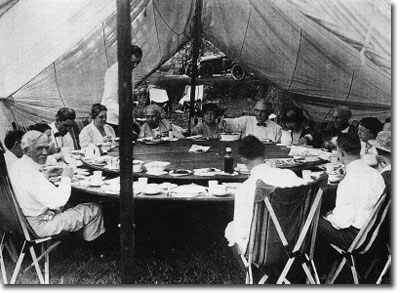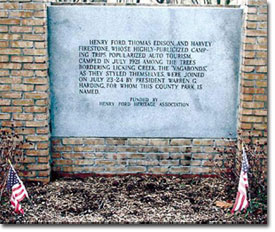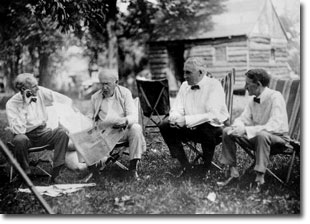Promote Outdoor Recreation with a President
By Francis Champ Zumbrun
“Imagine a scenario in which an outdoors-loving president
takes a sudden weekend leave from the White House to join up with three of
the most powerful industrialists in the Western world at a campsite in the
mountains of Western Maryland, where they ride horses, shoot rifles,
chop wood, and eat and sleep in tents beside a babbling brook.” - Norman Brauer, author of “There to Breathe the Beauty.”

During the week of July 21-27, 1921, Thomas Edison, Henry Ford
and Harvey Firestone camped at a site about six miles east of Hancock in
Washington County. During the weekend, President Warren G. Harding joined the
“vagabonds” — the name the wealthy industrialists gave themselves when they
camped together. The 200-acre farm where they made camp was located about one
mile north of the National Turnpike along Licking Creek. Today, the campsite
lies inside Camp Harding County Park. A plaque memorializes the gathering of
these famous campers.
This was not the first time the vagabonds had been in the Old
Line State. In 1918, while traveling from their camp site near Greensburg, Pa.,
to Leadmine, W.Va., the group passed through Garrett County. They stopped to eat
lunch at Swallow Falls and purchased supplies in Oakland.
 It wasn’t until the 1921 trip, however, that the vagabonds
actually camped in Western Maryland. There were several other firsts that
distinguished the 1921 outing from other trips the vagabonds had taken since
they began camping together in 1915. It was the first time their wives joined
them; it was the first time the president of the United States camped with them;
and it was the first time their friend, famed naturalist John Burroughs, was not
with them. He had passed away earlier that year.
It wasn’t until the 1921 trip, however, that the vagabonds
actually camped in Western Maryland. There were several other firsts that
distinguished the 1921 outing from other trips the vagabonds had taken since
they began camping together in 1915. It was the first time their wives joined
them; it was the first time the president of the United States camped with them;
and it was the first time their friend, famed naturalist John Burroughs, was not
with them. He had passed away earlier that year.
About mid-morning on July 23, 1921, Ford, Edison and Firestone left their
campsite at Licking Creek and drove west on U.S. Route 40 to Funkstown to meet
Harding, who had left the White House earlier that morning.
Large crowds gathered along the roadside in Hagerstown to watch the long caravan
of vehicles rumble by as they headed back to the camp site.
Harding’s group numbered more than 40 people and included, among others, Secret
Service personnel and 10 white house photographers. The vagabond’s entourage
included family members, cooks, truck drivers and maintenance staff. Including
the public hanging around to gawk at the famous, there were at times over 100
people crowding the camp site.
 Harding
and the vagabonds arrived back at Licking Creek at about 1 p.m. Newspaper
reporters wrote that the president arrived just in time to help cook for the
entire party. Reports say that Harding took off his coat, and with a
“business-like grip” around an ax, cut enough firewood to cook food for the
entire group.
Harding
and the vagabonds arrived back at Licking Creek at about 1 p.m. Newspaper
reporters wrote that the president arrived just in time to help cook for the
entire party. Reports say that Harding took off his coat, and with a
“business-like grip” around an ax, cut enough firewood to cook food for the
entire group.
After lunch, Harding retired to his tent to take a nap. A photographer also
captured a shot of Edison napping on the ground under an elm tree.
While the president and the inventor grabbed 40 winks, Ford and Firestone
conducted a wood-chopping contest for the benefit of the press and onlookers.
Despite the noise just outside his tent, Harding emerged rested and refreshed
from his hour-long nap and immediately went to the wood pile to chop more
firewood.
Afterwards, the president and Firestone walked over to Licking Creek, where
Harding reminisced about the swimming holes he enjoyed as a child.
 Firestone had shipped six horses from Ohio to the camp site, and Harding went
riding twice during his stay. A reporter noted that it was “the first horseback
work he (Harding) had done in many years.”
Firestone had shipped six horses from Ohio to the camp site, and Harding went
riding twice during his stay. A reporter noted that it was “the first horseback
work he (Harding) had done in many years.”
The adventures of the president and the vagabonds and their camping trip in
Maryland captured public imagination across America. In the early 1900s, camping
for fun in the outdoors was a relatively new concept. Some urban dwellers
believed that the only people who camped in tents were either in the Army or
were suffering hard times.
Many Americans worked a six-day week, laboring 10 or more hours each day. There
was little time for recreation. As more leisure time became available, people
began touring in their new automobiles and searching for vagabond types of
adventures. This created a demand for more public parks and forests, like Green
Ridge State Forest, one of Maryland’s public land crown jewels.
Photographs (top to bottom):
-
Gathered around their Lazy Susan camp table near
Hagerstown, Maryland in 1921, clockwise from just left of the tent pole,
(some partially hidden) are William F. Anderson, Methodist bishop of
Ohio; Harvey Firestone Sr.; George B. Christian. Jr.; Mrs. Thomas A.
Edison; Thomas Edison; Mrs. Henry Ford; President Harding; Mrs.
Firestone, Sr.; Henry Ford; Mrs. Anderson; Edsel B. Ford; Mrs.
Firestone, Jr.; Harvey Firestone, Jr. and Russell A. Firestone.
President Warren G. Harding (right of center) dines with Thomas Edison
(left of Harding) and Henry Ford (right of Harding). Credit: Library of
Congress.
- A plaque memorializes the famous vagabond campers at Camp Harding County Park.
-
Friends Henry Ford, Thomas Edison, President Warren G.
Harding and Harvey Firestone pictured on a camping trip that the four
took together in Maryland with members of their families. Photo courtesy
of the Ohio Historical Society.
-
Warren G. Harding, Harvey Firestone, Thomas Edison and
Henry Ford horseback riding through Maryland during a camping trip
in 1921.
Acknowledgements:
Maryland State Forester Francis Champ Zumbrun, author,
is the Manager of Green Ridge State Forest.
This is the second part of an occasional series about Thomas Edison,
Henry Ford and Harvey Firestone’s travels to Western Maryland,
originally published in the Cumberland Times News.
Back to Travelers Page